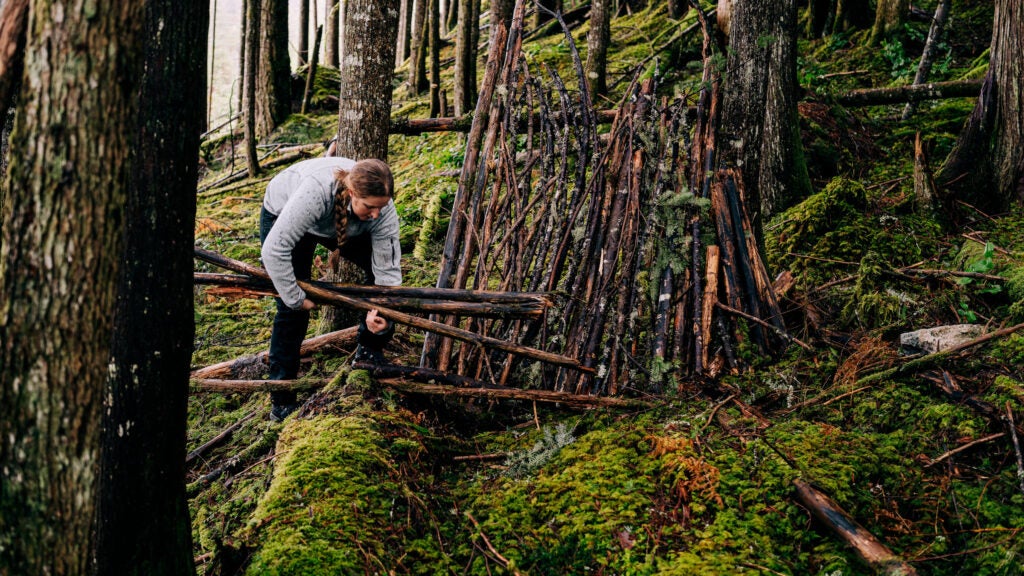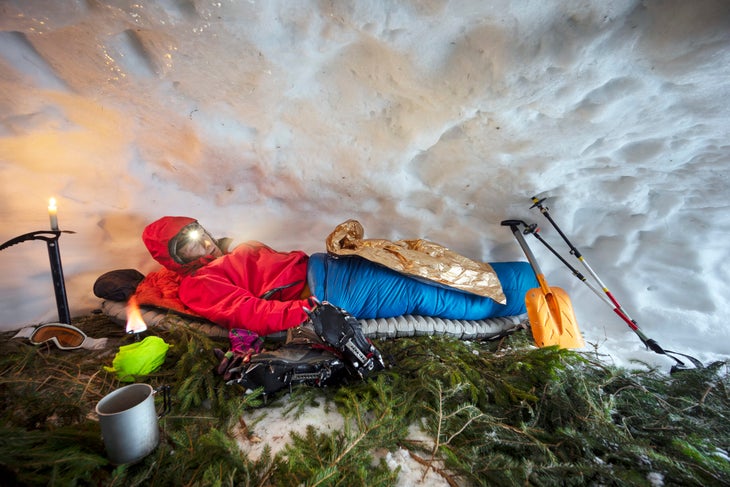



In her monthly column, The Survivalist, Jessie Krebs writes about staying alive in dangerous backcountry scenarios. Krebs is a former Air Force S.E.R.E (survival, evasion, resistance, and escape) instructor and owner of O.W.L.S. Skills.
Usually the first thing I do when I arrive at a new campsite is put up a shelter. After clothing, shelter is our best line of defense from the elements. There are several reasons you should build a shelter before starting a fire. First off, imagine starting a fire in nasty weather, with rain pouring down, snow falling thickly, and wind so strong it’s hard to stay upright. My odds of success are pretty low if I don’t put up a shelter first to protect the fire and keep my fuel dry. In that kind of weather, I’d rather snuggle into a warm dry sleeping bag, not do the rotisserie around a fire.
There is comfort in knowing that when I get tired, or if the weather shifts, I have a snug, warm, dry, place to rest, all ready to go. Shelter craft is a lot like building a sophisticated fort. There are so many different styles that it can get a bit mind-boggling. It is creativity, science, craftiness, skill, comfort, adventure, empowerment, intuitiveness, and more, all rolled into one activity.
There are some simple concepts that can drastically improve our odds of making a quick emergency shelter out of whatever is available. Survival isn’t necessarily about comfort, but if we are reasonably comfortable, we are more likely to survive. Getting good sleep and having a safe refuge goes a long way.
What you’re defending against informs the style of shelter you’ll build, and it usually falls between two extremes: Open and airy (hot weather) versus low and insulated (cold weather). First, identify what you need shelter from: cold or hot ground, hard rain, constant drizzle, swirling thick snow, intense wind, stiff breeze, sunlight, extreme heat, brutal cold, insidious chill, insects, predators, et cetera.
On average, a survival situation lasts about three days, so plan to spend at most an hour building your shelter and perhaps another hour to make a “sleeping bag” out of debris if you don’t have one. There’s no reason to build a log cabin or other elaborate shelter in a genuine survival situation. We want down and dirty while still being safe and reasonably durable. Use your time, energy, and materials as efficiently as possible.
Shelters come in many sizes, shapes, and materials. Don’t get hung up on what a shelter “should” look like. Look around and see the options for various shelter styles around you: Lean-to, A-frame, tree well, snow cave, platform, fan, quinzee, debris hut, wickiup, and teepee (with or without poles), are just a few. Each of these also have multiple variations, resulting in at least a hundred different unique options.
Scope out what you have on hand and decide how you’re going to use it. Have a length of line and a large piece of human-made material, like a bedsheet, the cloth lining on the ceiling of your vehicle, a tarp, raingear, or a mylar blanket? You can use it to build a shelter or save it to improvise a signal or sleeping bag and use natural materials like tree branches, leaves, grass, and snow to build your sleeping spot instead.
Once you know your style of shelter and what you will build it out of, you have to decide where to put your cozy little nest. A lot of factors come into play based on the circumstances and your ability to signal for help, which should always be your top priority in a survival situation. Choose a location that is as flat and level as possible, and is near your other resources like water. It should also be safe from deadfalls, widowmakers, falling rocks, large game trails, swarms of biting insects, flash flood zones, lightning, and other hazards. Each specific location will usually only have a few of these concerns, so identify the potential threats and plan accordingly.

Measure the area that needs to be covered before you begin. Make it large enough for the number of people in your group and their equipment. Then, prepare the site by clearing out things you don’t want to sleep on or have hanging in your face. Leave things, like leaves and grass, that will help insulate you from the ground. Don’t underestimate the power of conduction. The ground on average is about 45°F, which is awesome if you’re trying to cool down, but terrible if you’re trying to stay warm. If you have a sleeping pad, use it. If not, use debris to make an insulated bed that is at least a foot thick before you lay down on it. In many scenarios it’s much easier to build a natural insulation bed first and then build the shelter around it.
Make your entrance 90 degrees to the wind. This prevents a wind tunnel or a wind eddy effect. Secure materials on the shelter frame from the bottom up to create a shingle effect—rain falls from the top layer onto the next one down and so on until it hits the ground. (Note: A few basic knots can come in especially handy when it comes to shelter construction. I teach 5 basic ones in my one-day survival classes: bowline, slip loop, running loop, slipped half-hitch, and trucker’s hitch. Once you know them, learn how to apply them in real-world scenarios. Practice doing them blind, opposite-handed, behind your back, and so on.)
Never have more than three people in a fully enclosed snow shelter (make more shelters if you have more than three people), and always make an air vent exiting the shelter 90 degrees to the wind and at a 45 degree angle. It should be about 1 to 2 inches in diameter.
You may angle a tarp in such a way that you can also collect rainwater for drinking and other uses. To shed rain, natural materials need to sit at least a 60 degree angle from the ground. Any flatter and heavy rain is likely to leak through.
Don’t eat or store food in a shelter. Make a separate critter or bear hang depending on the environment and season. Brush snow, dirt, and crumbs off of yourself before entering a shelter. Air your bedding materials out as best you can every day.
If you roll around a lot in your sleep, consider using bed logs or other materials to put on either side of you to keep you from rolling out of your shelter.
If insects are a major concern, consider smoking the shelter (putting fragrant plant material on a hot coal inside the sealed shelter to create a lot of smoke and drive out insects. Be careful not to accidentally set your new home on fire).
From 2023

